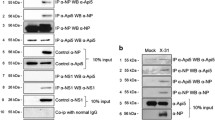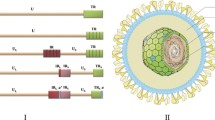Abstract
Hazara virus (HAZV) is closely related to Crimean-Congo hemorrhagic fever virus (CCHFV), but differs in that it is non-pathogenic to humans. Since HAZV was isolated for the first time in 1954, the biological characteristics of this virus, particularly its behavior within culture cells, have not been well-studied, despite its importance as a surrogate model for CCHFV. Nucleoprotein (N) is the main component of viral nucleocapsid and is the most abundant virion protein, it is believed to play a pivotal role in the viral lifecycle. Generation of a series of anti-HAZV N monoclonal antibodies has enabled us to directly examine the involvement of this protein on viral growth. Observation of HAZV-infected cells revealed that this infection caused apoptosis, which was further characterized by DNA ladder and elevated caspase-3/7 activity. HAZV titers initially increased in cell culture, but after reaching the peak titer began to rapidly decline. HAZV particles were found to be very unstable in culture medium at 37 °C, and virus particles tend to lose infectivity at that point. HAZV N appears to inhibit apoptosis, thus can potentially support efficient viral propagation.







Similar content being viewed by others
References
Elliott RM, Schmaljohn C (2013) Bunyaviridae. In: Knipe DM, Howley PM, Cohen JI, Griffin DE, Lamb RA et al (eds) Fields virology, 6th edn. Lippincott Williams & Wilkins, Philadelphia, pp 1244–1282
Jeeva S, Cheng E, Ganaie SS, Mir MA (2017) Crimean-Congo hemorrhagic fever virus nucleocapsid protein augments mRNA translation. J Virol 91:e00636-17. https://doi.org/10.1128/JVI.00636-17
Guo Y, Wang W, Ji W, Deng M, Sun Y et al (2012) Crimean-Congo hemorrhagic fever virus nucleoprotein reveals endonuclease activity in bunya viruses. Proc Natl Acad Sci USA 109:5046–5051. https://doi.org/10.1073/pnas.1200808109
Wang W, Liu X, Wang X, Dong H, Ma C et al (2015) Structural and functional diversity of nairovirus-encoded nucleoproteins. J Virol 89:11740–11749. https://doi.org/10.1128/JVI.01680-15
Capodagli GC, Deaton MK, Baker EA, Lumpkin RJ, Pegan SD (2013) Diversity of ubiquitin and ISG15 specificity among nairoviruses’ viral ovarian tumor domain proteases. J Virol 87:3815–3827. https://doi.org/10.1128/JVI.03252-12
Deaton MK, Dzimianski JV, Daczkowski CM, Whitney GK, Mank NJ et al (2016) Biochemical and structural insights into the preference of nairoviral deISGylases for interferon-stimulated gene product 15 originating from certain species. J Virol 90:8314–8327. https://doi.org/10.1128/JVI.00975-16
Scholte FEM, Zivcec M, Dzimianski JV, Deaton MK, Spengler JR et al (2017) Crimean-Congo hemorrhagic fever virus suppresses innate imune responses via a ubiquitin and ISG15 specific protease. Cell Rep 20:2396–2407. https://doi.org/10.1016/j.celrep.2017.08.040
Dowall SD, Findlay-Wilson S, Rayner E, Pearson G, Pickersgill J et al (2012) Hazara virus infection is lethal for adult type I interferon receptor-knockout mice and may act as a surrogate for infection with the human-pathogenic Crimean-Congo hemorrhagic fever virus. J Gen Virol 93:560–564. https://doi.org/10.1099/vir.0.038455-0
Smirnova SE, Shestopalova NM, Reingold VN, Zubri GL, Chumakov MP (1977) Experimental Hazara virus infection in mice. Acta Virol 21:128–132
Bereczky S, Lindegren G, Karlberg H, Akerström S, Klingström J et al (2010) Crimean-Congo hemorrhagic fever virus infection is lethal for adult type I interferon receptor-knockout mice. J Gen Virol 91:1473–1477. https://doi.org/10.1099/vir.0.019034-0
Matsumoto Y, Ohta K, Nishio M (2018) Lethal infection of embryonated chicken eggs by Hazara virus, a model for Crimean-Congo hemorrhagic fever virus. Arch Virol 163:219–222. https://doi.org/10.1007/s00705-017-3580-1
Xia H, Zhao J, Li Y, Yin S, Tang S et al (2013) Infection and propagation of Crimean-Congo hemorrhagic fever virus in embryonated chicken eggs. Virus Res 173:344–349. https://doi.org/10.1016/j.virusres.2013.01.008
Guler N, Eroglu C, Yilmaz H, Karadag A, Alacam H et al (2016) Apoptosis-related gene expression in an adult cohort with Crimean-Congo hemorrhagic fever. PLoS One 11:e0157247. https://doi.org/10.1371/journal.pone.0157247
Güven AS, Sancakdar E, Uysal EB, Kaya A, Oflaz MB et al (2015) Evaluation of serum perforin, caspase-3, sFasL and M-30 levels as apoptotic markers in children with crimean-congo hemorrhagic fever. J Pediatr Infect Dis 34:208–213. https://doi.org/10.1097/INF.0000000000000530
Karlberg H, Tan YJ, Mirazimi A (2015) Crimean-Congo haemorrhagic fever replication interplays with regulation mechanisms of apoptosis. J Gen Virol 96:538–546. https://doi.org/10.1099/jgv.0.000011
Karlberg H, Tan Y, Mirazimi A (2011) Induction of caspase activation and cleavage of the viral nucleocapsid protein in different cell types during Crimean-Congo hemorrhagic fever virus infection. J Biol Chem 286:3227–3234. https://doi.org/10.1074/jbc.M110.149369
Lasecka L, Baron MD (2014) The molecular biology of nairoviruses, an emerging group of tick-borne arboviruses. Arch Virol 159:1249–1265. https://doi.org/10.1007/s00705-013-1940-z
Surtees R, Ariza A, Punch EK, Trinh CH, Dowall SD et al (2015) The crystal structure of the Hazara virus nucleocapsid protein. BMC Struct Biol 15:24. https://doi.org/10.1186/s12900-015-0051-3
Surtees R, Dowall SD, Shaw A, Armstrong S, Hewson R et al (2016) Heat shock protein 70 family members interact with Crimean-Congo hemorrhagic fever virus and Hazara virus nucleocapsid proteins and perform a functional role in the nairovirus replication cycle. J Virol 90:9305–9316. https://doi.org/10.1128/JVI.00661-16
Molinas A, Turkina MV, Magnusson K-E, Mirazimi A, Vikström E (2017) Perturbation of wound healing, cytoskeletal organization and cellular protein networks during Hazara virus infection. Front Cell Dev Biol 5:98. https://doi.org/10.3389/fcell.2017.00098
Begum F, Wisseman CL Jr, Casals J (1970) Tick-borne viruses of West Pakistan. II. Hazara virus, a new agent isolated from Ixodes redikorzevi ticks from the Kaghan Valley, W. Palostan. Am J Epidemiol 92:192–194
Nishio M, Tsurudome M, Ito M, Garcin D, Kolakofsky D et al (2005) Identification of paramyxovirus V protein residues essential for STAT protein degradation and promotion of virus replication. J Virol 79:8591–8601
Nishio M, Tsurudome M, Ishihara H, Ito M, Ito Y (2007) The conserved carboxyl terminus of human parainfluenza virus type 2 V protein plays an important role in virus growth. Virology 362:85–98
Goto H, Ohta K, Matsumoto Y, Yumine N, Nishio M (2016) Evidence that receptor destruction by the Sendai virus hemagglutinin-neuraminidase protein is responsible for homologous interference. J Virol 90:7640–7646. https://doi.org/10.1128/JVI.01087-16
Andersson I, Simon M, Lundkvist Å, Nilsson M, Holmström A et al (2004) Role of actin filaments in targeting of Crimean Congo hemorrhagic fever virus nucleocapsid protein to perinuclear regions of mammalian cells. J Med Virol 72:83–93
Andersson I, Bladh L, Mousavi-Jazi M, Magnusson K-E, Lundkvist A et al (2004) Human MxA protein inhibits the replication of Crimean-Congo hemorrhagic fever virus. J Virol 78:4323–4329
Wang Y, Dutta S, Karlberg H, Devignot S, Weber F et al (2013) Structure of Crimean-Congo hemorrhagic fever virus nucleoprotein: Superhelical homo-oligomers and the role of caspase-3 cleavage. J Virol 86:12294–12303. https://doi.org/10.1128/JVI.01627-12
Welch SR, Scholte FEM, Flint M, Chatterjee P, Nichol ST et al (2017) Identification of 2′-deoxy-2′-fluorocytidine as a potent inhibitor of Crimean-Congo hemorrhagic fever virus replication using a recombinant fluorescent reporter virus. Antiviral Res 147:91–99. https://doi.org/10.1016/j.antiviral.2017.10.008
Hardestam J, Simon M, Hedlund KO, Vaheri A, Klingström J et al (2007) Ex vivo stability of the rodent-borne Hantaan virus in comparison to that of arthropod-borne members of the Bunyaviridae family. Appl Environ Microbiol 73:2547–2551
Wolff S, Becker S, Groseth A (2013) Cleavage of the Junin virus nucleoprotein serves a decoy function to inhibit the induction of apoptosis during infection. J Virol 87:224–233. https://doi.org/10.1128/JVI.01929-12
Acknowledgements
We thank Prof. Roger Hewson (Public Health England) and Jiro Yasuda (Nagasaki University) for providing HAZV and SW13 cells. We thank Prof. Keizo Tomonaga (Kyoto University) for the gift of plasmids. We also acknowledge proofreading by Benjamin Phillis.
Funding
This study was funded by JSPS KAKENHI Grant Number JP17K08864.
Author information
Authors and Affiliations
Corresponding author
Ethics declarations
Conflicts of interest
The authors declare that they have no conflict of interest.
Ethical statement
All procedures performed in studies involving animals were in accordance with the ethical standards of Wakayama Medical University, Japan.
Additional information
Handling Editor: Hideki Ebihara.
Publisher's Note
Springer Nature remains neutral with regard to jurisdictional claims in published maps and institutional affiliations.
Rights and permissions
About this article
Cite this article
Matsumoto, Y., Nouchi, T., Ohta, K. et al. Regulation of Hazara virus growth through apoptosis inhibition by viral nucleoprotein. Arch Virol 164, 1597–1607 (2019). https://doi.org/10.1007/s00705-019-04236-7
Received:
Accepted:
Published:
Issue Date:
DOI: https://doi.org/10.1007/s00705-019-04236-7




